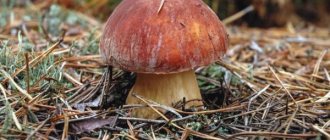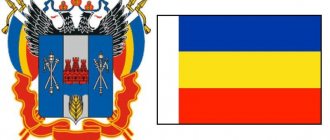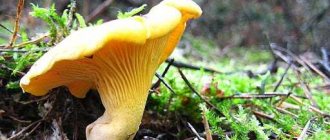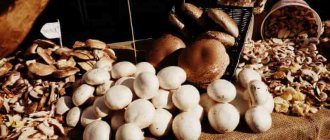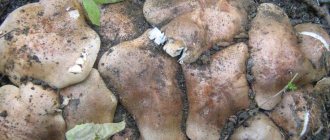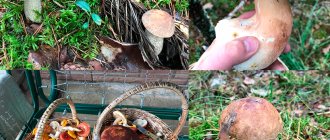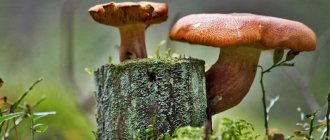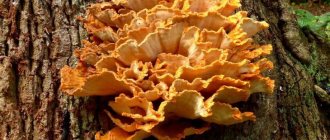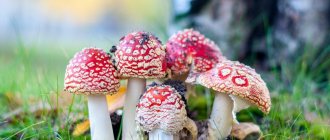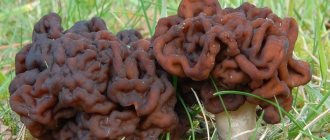Mushroom places in the Saratov region in 2022 are found in large numbers, if there were appropriate weather and mushroom season. Every avid mushroom picker in Saratov knows his treasured place, but its location is usually kept secret, although during the season most mushroom lovers go to the same places in droves. In this article we will try to reveal some of the secrets of mushroom pickers; here are all the most famous mushroom places in the Saratov region - forests and forest plantations with moist, well-warmed areas by the sun, with an abundance of symbiont trees and soil rich in organic matter.
Edible mushrooms love rainy, cool weather. Therefore, the best time to collect mushrooms is autumn (before the first frost, from late August to late October) or late May - early June. Experienced mushroom pickers know where to go to pick mushrooms in the Saratov region, where mushrooms grow in the Saratov region and that most often successful mushroom places are located in sunny, elevated places, well-warmed forest edges, wind-blown pine forests, in rare aspen, light oak and birch groves, on old forest paths.
Mushrooms of the Saratov region
There are a lot of mushrooms in the region and near the city of Saratov, and anyone who is planning to go for them should know exactly which species are edible. It would also be useful to have a list of mushroom places so that you don’t have to wander through the forest at random.
In total, more than 2,000 different mushrooms are found in the region, which can be divided into 25-40 groups (according to different classifications). There are about 150 edible ones, but less than 20 are popular. Many species are rare, while others are little known, and therefore people do not take them.
The number of mushrooms in the Saratov region is determined by weather conditions. In dry years, these gifts of nature simply do not come out of the ground. Unusually cold weather also does not contribute to their appearance, but late species (those that grow before October) are not so dependent on heat and appear even during early frosts.
Coat of arms and flag of the Saratov region
Forest park near the village of Tin-Zin
The area is rich in mushrooms
On the outskirts of the city of Engels there is a long forest area (950 hectares). The forest is located on flat terrain and is represented exclusively by deciduous trees. Here you can find oak, linden, and birch. There are many streams in the territory, there are lakes, as well as swampy areas.
Irina Selyutina (Biologist):
A forest park is a vast natural forest, which is usually located near or inside a large populated area, adapted (“cultivated”) for mass recreation, sports, entertainment and satisfying the cultural and aesthetic needs of people. Activities for “cultivation” may be limited to the construction of trails and the installation of benches for rest, or the creation of specially designed complexes of small-scale architecture in combination with sports and recreational facilities and facilities. In forest parks, activities are also carried out to enrich flora and fauna. There may also be ponds on the territory of the forest park.
Edible mushrooms grow here in abundance during the season. Mostly boletus, milk mushrooms, and boletuses are found. They collect pigs and boletus. The most mushroom places are near lakes Kastorovoye and Pionerskoye. The forest belt occupies a large area, so mushroom pickers have to travel considerable distances in search of edible “trophies.”
Edible mushrooms
Edible mushrooms are the main reason why people go to the forest in the fall. There are about 150 species of them in the Saratov region, but most are very rare. The mushrooms that grow in every forest in the region are worth taking a closer look at.
boletus
boletus
Different types of boletus differ only in the color of the cap. The shade varies from light brown with a grayish tint to dark brown. The cap is dome-shaped, and the stem is covered with fibers that darken in adult mushrooms, creating a recognizable texture.
When the boletus is broken, its flesh does not change color. The smell and taste are very weak, but become expressive after cooking. Boletus mushrooms are boiled, fried, pickled and dried.
Boletus
These mushrooms have a smooth cap, often bright orange, but sometimes light brown. It is shaped like a pillow. The leg, like that of boletus mushrooms, is covered with vertical fibers. But they are not only dark, but also white. The color of the pulp is white, but when damaged it often darkens or turns red.
A distinctive feature is that boletuses appear in waves from the very beginning of summer. In between, it is almost impossible to find them. It is prepared in different ways, but the most flavorful is mushroom soup.
Boletus
White mushrooms
Porcini
There are other representatives of the boletus genus in the Saratov region, but the white one is the most common of them. The cap of this noble mushroom comes in different colors - from light beige to dark brown. The shade depends on the characteristics of the forest, weather and other natural conditions. The hat of a young person looks like a hemisphere, while that of a mature one looks like a pillow.
The pulp is dense, white (hence the name), almost odorless, but has a nutty flavor. The leg is thick and long, half underground. White mushrooms are eaten in any form - it is considered one of the best mushrooms.
Expert opinion
Melnikov Vladimir Mikhailovich
Knows 1000 ways to cook, pickle and marinate any types of mushrooms
In appearance and taste, the white one is similar to its relative - the oak tree. The only difference between them is that the flesh of the oak wood becomes very dark during heat treatment, while the white wood remains light.
Milk mushrooms
White mushrooms with a lamellar cap structure. The top is most often mucous, but adults are sometimes dry due to weather conditions. The stem of the milk mushroom is hollow, and the cap resembles a funnel, even on a young mushroom. The pulp is milky in color, but after cooking it becomes gray-blue.
Milk mushrooms most often grow in young forests. They are prepared in any way, but they taste best when salted and pickled.
Real milk mushroom
Russula is nice
Loadings
Formally, these mushrooms belong to the Russula mushrooms, but they got their name because of their resemblance to milk mushrooms. Young caps have a rounded cap, with a hole in the center, while mature ones have a funnel-like cap. Color – white, sometimes with brownish spots.
The bottom of the cap is lamellar and breaks easily. The leg is short. They are fried and pickled, less often - boiled. Many types of loads, when damaged, release a milky liquid that is very bitter. Therefore, they are soaked in salt water for at least 8 hours before cooking.
Butter
There are many types of butterfish, but they are all similar. The name is due to the fact that the cap is always covered with mucous skin. It can be easily removed. The color palette is different, ranging from olive-gray to chocolate. Sometimes yellowish species are also found. The cap is at first in the shape of a hemisphere, but in older ones it opens up.
The stem of the butterdish is lighter than the cap, and in the middle there is a white film ring. They are very susceptible to pests, so finding a non-wormy mushroom is sometimes problematic. But if you’re lucky, all that remains is to remove the skin, and the butterdish can be prepared in any way.
Butter
Ryzhik
Saffron milk caps
In many regions of Russia and the CIS, saffron milk caps stopped appearing 10-20 years ago, but this did not affect the Saratov region. Bright red, often even reddish mushrooms have such an unusual color due to their high beta-carotene content. The hat resembles a funnel, like a milk mushroom.
There are plates under the cap. The pulp is brittle, does not change color when damaged and does not smell anything. Roasted and salted saffron milk caps taste best.
Chanterelle
Chanterelles
These are mushrooms of various shapes and sizes, although most often quite small. But due to their characteristic yellow color, they cannot be confused with anything else. The stem is thin at the bottom and widens at the top, often growing to the cap.
Chanterelles have a specific smell of dried fruits, and they taste slightly sour. Most often they are fried and salted.
There are poisonous counterparts - false chanterelles . But it’s easy to distinguish them from the real ones - “false chanterelles” grow mainly on rotten wood, and not in the ground. In addition, the poisonous counterparts have a more aggressive orange color.
Russula Food
Russula
The largest group of edible mushrooms. A total of 275 species are registered, but in the Saratov region up to 60 are found. They all taste approximately the same, but differ in the color of the skin (which, by the way, can be easily removed) and sometimes the density of the pulp. So, red russulas are brittle, but green ones, especially when young, are much stronger. The leg is almost always white.
The taste of russula can be different - some are tender and sweet, others with a pronounced bitterness. Because of this, many types of russula are classified as conditionally edible, because before cooking they have to be soaked to remove the bitterness. But common types of russula are not bitter.
Expert opinion
Melnikov Vladimir Mikhailovich
Knows 1000 ways to cook, pickle and marinate any types of mushrooms
Due to their fragility, they are not suitable for pickling and drying. Most often they are fried.
Umbrellas
Outwardly they resemble what they are named after. A thin stem and an open dome of the cap are characteristic even of young umbrellas. The closest relatives of these specific mushrooms are forest champignons.
The cap has brown scales, darker than the cap itself. A mature mushroom has a dark brown bump in the center.
Young umbrellas are eaten whole, but the stem of old ones is thrown away because it hardens too much. Due to the distinctive mushroom aroma, umbrellas are sold at a high price in many countries around the world, including Western Europe. Most often, mushrooms are fried - in this form they resemble chicken meat.
Umbrella blushing
Honey mushrooms
Honey mushrooms
Honey mushrooms come in different varieties and grow throughout the mushroom season. But most common in the Saratov region are autumn honey mushrooms. These are light brown mushrooms with thin stems and dome-shaped caps that open up as they age. There are scales on the cap, usually closer to the edges, and a filmy ring on the stem.
Old honey mushrooms usually only eat the caps, as the stems become tough and crumble into long fibers. These mushrooms are fried and boiled. Young honey mushrooms are very good when salted and pickled.
Thick-legged morel
Morels
These mushrooms with wrinkled egg-shaped caps are the earliest. They can be found as early as April, and by the beginning of summer their season is already over. Very fragrant and with fancy legs, they are unlike any poisonous mushroom known to science.
However, the morels themselves need to be soaked before cooking, otherwise there is a risk of mild food poisoning. They are not salted or pickled, but they are good fried, boiled and stewed. They can also be dried.
Close relatives of morels are strings. They are very similar in appearance and quality, but the wrinkles on the cap of the stitches are much thicker.
Inedible
The difference between inedible mushrooms is that they look very similar to the good edible species. But at the same time they have an unpleasant taste, and some of them are even poisonous.
Ryadovka
Rows
About 90 species of mushrooms are called rows. Some of them are even poisonous, but in the Saratov region none of them (except tiger, which causes serious gastrointestinal disorders) do not grow. Here you can find conditionally edible and inedible species.
Skin color - a variety of colors and shades. It is not difficult to distinguish the russula from the russula - the stem of the russula is rarely white, most often it either matches the color of the cap or has a “non-mushroom” color (blue, purple, etc.).
Many rows have a bitter or pungent taste. Others are ok, but almost tasteless. To get rid of bitterness, they are soaked in salt water. But most mushroom pickers prefer not to collect them at all.
Valui
In general, conditionally edible, but bitter mushrooms. They have an unpleasant odor, vaguely reminiscent of spoiled oil. The skin on the cap is red-brown or yellow, slimy.
The young ones look like a ball due to the fact that the cap is bent and its edges are adjacent to the base of the stem. Valui can be salted and pickled after thorough soaking, but beginners should avoid them altogether, especially since the forests of the Saratov region are rich in edible mushrooms.
Valuy
Yellow-skinned liverworts
Yellow-skinned champignon
These mushrooms are similar to forest champignons, but, unlike the latter, they are considered inedible. Their use may be associated with intestinal upset, vomiting, and fever.
Since forest champignons are quite rare in the Saratov region, novice mushroom pickers are not recommended to collect them. There is a high probability that it will be a yellow-skinned stove.
Satanic mushrooms
Large and attractive, these mushrooms could pass for boletus or even white mushrooms, if not for their specific smell. They smell like rotting onions. In addition, the surface of their cap is smoother than that of edible mushrooms.
Satanic mushroom
Theoretically, satanic species can be eaten, but to eliminate toxins they have to be soaked for at least 10 hours, and then boiled for a long time. And it’s not worth it, because the taste of the satanic mushroom is not pleasant.
Yagodnaya Polyana village
A huge forest area is located between four settlements of Tatishchevsky and Petrovsky districts. It starts behind the village of Yagodnaya Polyana and continues to the villages of Ozerki, Orkino, Sokur. The forest is a mixture of deciduous trees with small patches of pine.
Here you can find boletus, boletus, boletus, and honey mushrooms. There are milk mushrooms, as well as pig mushrooms, russula of different colors, rows, talkers, and umbrella mushrooms.
Do you know about umbrella mushrooms that ...
- Only some of the umbrella mushrooms belong to the genus Macrolepiote (umbrella mushroom), while the rest are scattered among other genera.
- The diameter of the cap of some species can reach 35 cm, with a stem length of 40 cm.
- Most species are typical saprotrophs.
- Umbrella mushrooms are cosmopolitan, absent only from Antarctica.
- When you touch the surface of the cap, it begins to turn yellow or acquire a brown tint.
- When developing in the complete absence of light, or vice versa, with continuous light, fruiting bodies of an ugly shape are formed and do not produce spores.
Poisonous
In the Saratov region you can find more than 150 varieties of poisonous species. They should not be collected under any pretext - even contact with human skin can have negative health consequences.
Fly agarics
Fly agarics
The most numerous category of poisonous mushrooms. They cannot be called particularly dangerous - the lethal dose is quite large (from 5 to 10 g). However, it is better to avoid fly agarics. Fortunately, they immediately catch your eye because of their bright colors. Most types of fly agarics are red, green or yellow, with caps covered with white spots.
Pale toadstools
Toadstool pale
Distant relatives of fly agarics and one of the most dangerous mushrooms. They secrete poison so “violently” that after briefly touching a toadstool, you need to wash your hands with soap. And if the pale toadstool got into a basket with edible mushrooms, then after discovering this annoying fact you will have to throw away all the catch. Although it’s a pity, you definitely shouldn’t risk your health and life.
The shape of toadstool caps varies from cushion-shaped to egg-shaped. The skin is pale green, often covered with white growths resembling flakes.
False values
Hebeloma adhesive
Real valui is conditionally edible - its bitterness disappears after soaking. But for false value it remains regardless of processing. Another name for the false one – horseradish mushroom – speaks for itself.
Another option is adhesive hebeloma. The strong odor and unpleasant taste of horseradish make it inedible.
Talkers
Talker brown-yellow
These unremarkable mushrooms are similar to row mushrooms, but are much more dangerous. Some species are simply inedible, while others are lethal if consumed at 10 grams or more. Most talkers are white or cream, sometimes with a pink tint. They are easy to recognize because in appearance they only look like milk mushrooms, but do not have a depression in the cap.
Fiber racks
Patouillard fiber
Very dangerous mushrooms - the concentration of poison in them is 20 times greater than in fly agaric mushrooms. Even from inhaling fumes from fiberglass you can get poisoned. Fortunately, the mushroom is easy to recognize - it is unlike any other species.
The cap is usually reddish, resembles a cone, but in mature mushrooms it opens and cracks. The fibers smell like alcohol or ground pepper.
Cobwebs
Cobweb spider
These mushrooms act unlike other poisonous species - they affect the kidneys, and not the gastrointestinal tract or nervous system. They are among the most poisonous mushrooms, since the toxins contained in them cannot be removed or destroyed.
The cobweb looks like a rotten honey fungus - brown, shiny, seems wet. But, unlike honey fungus, there are usually no scales on the cap of this mushroom, the plates below are much sparser, and there is no ring of film on the stem. Also, the cap at the edges is often lighter than in the center.
Symptoms and first aid for poisoning
You may be interested in: How do edible talkers differ from false mushrooms? How many days after rain do mushrooms grow? Bitter mushroom: photo and detailed description
Signs of poisoning by inedible mushrooms can vary somewhat. This depends on the type of toxin. However, there are a number of common symptoms:
- vomit;
- diarrhea;
- fever;
- weakness;
- severe abdominal pain;
- migraine.
Blood pressure and pulse may drop, vision may deteriorate, hallucinations, delirium, and convulsions may occur. Poisoning is often accompanied by dry mouth, thirst, and difficulty breathing.
At the first signs, you should immediately call an ambulance. Before the doctor arrives, you should immediately rinse the victim’s stomach with clean salted water or a weak solution of potassium permanganate. After washing, they give a laxative and do an enema.
The patient is given plenty of fluids (warm water) and sorbents (Rehydron, Enterosgel or activated carbon at the rate of 1 tablet per 10 kg of weight). The victim's limbs are rubbed and covered warmly. You can put a cold compress on your head.
Not all mushrooms are safe for health. Some cause severe poisoning, even death. Collection is complicated by the fact that edible and poisonous fruits are often very similar to each other. Before picking mushrooms, you need to study their differences. In the forest, carefully examine each of them and under no circumstances take a mushroom if you doubt its edibility.
Mushroom places
Edible mushrooms are found almost everywhere in the Saratov region. But the most productive places are considered to be the following.
| Place of distribution. | Kinds. |
| Bazarno-Karabulaksky district. | Dubovitiki (varieties of porcini mushrooms), boletus mushrooms. |
| Baltaysky district. | Boletus mushrooms, boletus mushrooms, honey mushrooms, boletus mushrooms. |
| With. Popovka, Saratov district. | Boletus mushrooms, milk mushrooms. |
| village Ivanteevka, Krasnoarmeysky district. | Porcini mushrooms, boletus mushrooms. |
| With. Zvonarevka, Marksovsky district. | Porcini and oak mushrooms, aspen mushrooms, saffron milk caps. |
| lake Tin-Zin, Engels district. | Boletuses, milk mushrooms. |
| With. Kamyanka, Tatishchevsky district. | Butter. |
| With. Yagodnaya Polyana, Tatishchevsky district. | Chanterelles, saffron milk caps. |
Almost every forest in the region has a wide variety of mushrooms. The only difference is the quantity. Mushroom pickers should pay special attention to sunny edges, hills, aspen forests, “pure” pine forests, oak and birch groves, old unused paths and roads in the forest.
Popovka village
Here is the closest mushroom forest to the city of Saratov (and, accordingly, the regional center). It stretches between the villages of Popovka and Sosnovka. Mushroom pickers travel from Saratov by bus towards the village of Sbrodovki. A road leads to the forest from this village, but the forest itself grows in the tract. The places here are uneven, with elevation changes, so in search of mushrooms, you will have to climb steep and lowlands.
The forest is old, pine. Trees are 100-200 years old. Pine plantations are adjacent to oak forest. Boletus, boletus, and saffron milk caps grow here.
Irina Selyutina (Biologist):
Mushrooms are living organisms, like all life forms on our planet. And they are also affected by parasites. And one of these parasitic fungi, the species Pekiella brick-red from the family Hypomycetes, has chosen the fruiting bodies of saffron milk caps. As studies have shown, during its development, its mycelium causes a reduction (simplification) of the hymenophore plates and almost completely covers the entire lower side of the cap. Such saffron milk caps are called “stone” or “deaf”. Their plates are not able to form spores. Experts do not recommend collecting such fruiting bodies.
There are many other mushrooms too. There are volushki, milk mushrooms, rows, talkers.
What is collected in spring, summer and autumn
| Mushrooms. | When to collect. |
| Morels, Stitches. | April May. |
| Summer honey mushrooms. | Second half of April – October. |
| Boletus mushrooms. | May – June (with frequent rains). August – November. |
| Meadow honey mushrooms. | May (if it rains) – October. |
| Butter. | May (with frequent rains) – first half of November. |
| Duboviki. | Second half of May – September. Most of all - in August. |
| Umbrellas. | June – September. Most of all - in August. |
| Forest champignons. | June – September. |
| White mushrooms. | June – October. Most of all - in the second half of August and September. |
| Boletuses. | June (first wave). Second half of July – first half of August (second wave). September – November (mostly). |
| Saffron milk caps. | June (with frequent rains) – October. |
| Russula | July – September. |
| Boletuses, Chanterelles. | July – October. |
| Loadings. | Second half of July – October. |
| Milk mushrooms, Valui, autumn honey mushrooms. | August – October. |
Mushrooms of the Saratov region listed in the Red Book
- Rooted brown-yellow boletus.
- Varnished tinder fungus.
- Polyporus root-loving.
- Sparassis curly.
- Coral-shaped hedgehog.
- Pistil horn.
- Gyropor chestnut.
- The gyropore is blue.
- Girlish umbrella mushroom.
- Langermannia gigantea.
- Earth star fringed.
- Earth star warty.
- Earth star dwarf.
- Earth star of kotlab.
- The earth star is false-edged.
- Earth star striped.
- Earth star crowned.
- Earth star flower-shaped.
- Mutinus Ravenel.
- Parmelia wandering.
